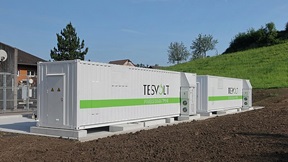Recently, RethinkX published an article by Taylor Hinds on battery storage. We need such a storage in order to turn the intermittent solar and wind energies into a continuous energy supply. She writes that ‘unsubsidized solar and wind energies are the cheapest form of electricity already in many locations’. If we add batteries, we will get an SWB system (solar, wind and batteries) that can fulfil all our energy needs.

Solar and wind energies need batteries
In many locations, solar and wind-powered electricity are the cheapest form of energy production already. But these sources do not deliver if the sun doesn’t shine and the wind doesn’t blow. Therefore, we need batteries.
Batteries, Hinds writes, fulfil a number of important functions. They balance the intermittency of renewables: they store an excess of energy (particularly on sunny and windy days) and release this again when demand is high. Backup power and resiliency: they deliver electricity in case of outages or emergencies. And grid stabilization and peaking: They can deliver an extra amount of electricity when demand is high (for this, the fossil system uses peaking units).
Growth
Already, batteries render useful services. For instance, last August in Texas, the electricity system kept on functioning during a heatwave; consumers didn’t have to be careful to use electricity (for instance, by refraining from using air conditioners), like they would have had to. And in September in California, no emergency was called, even though there was pressure on the electricity system because of wildfires.
In the past few years, the amount of battery storage on the net in the United States has grown appreciably. Utilities build these batteries on a local or regional scale, by way of sustaining their clients. Hinds writes that the world had about 56 GW in battery storage by the end of 2023, equivalent to 200 GWh electricity delivered; compare that to just 3 GW, 5 years ago. But yet, this would service the city of New York for just a day and a half.

The importance of battery storage
So, although the performance of the battery system is relatively modest at the moment, it grows incredibly fast. By 2030, regions could become self-sufficient because of a large number of batteries connected to the grid. But as solar and wind electricity are cheaper than batteries (whereas their prices fall all the time), it would be sensible to construct an excess of cheap energy production capacity. Illustrated by the Clean Energy U-Curve. RethinkX even developed the concept of SWB Superpower – cheap, clean and abundant electricity.
Battery storage has the advantage that this can be applied anywhere in the world. And this decentralized technology can be used at any scale, from the household up to the grid. Depending on the case considered. Many battery systems are an add-on to solar or wind production units. But so far, there are just two major centres of battery storage in the world: China (~27 GW) and the United States (~16 GW). According to RethinkX, the largest system in the world right now is the Edwards & Sandborn Solar Plus Storage Project in California, finished in January 2024. The huge battery system combines with a solar production unit, and measures 875 MW in capacity; it can deliver the huge amount of 3.3 GWh of electricity. And then, this isn’t even the only solution. Standalone systems are equally possible.
Falling costs for lithium-ion batteries
Battery storage could grow fast, particularly because of falling costs of lithium-ion batteries. Mainly through China. According to Wright’s Law, costs tend to fall as cumulative production grows. China is the most important producer of lithium-ion batteries. It now produces a stunning 76% of all lithium-ion batteries in the world, ten times as much as the United States. And the Chinese production volume still grows: this year, it is 33% higher than last year. An important factor here is the growth of the number of electric cars. Since 2010, the costs of lithium ion batteries have fallen by 88%. In 2023, production amounted to a huge volume, 1 TWh, of which almost 15% was for energy storage. The sector expects growth to continue, anyway up to 2030. But then, there are many more options for energy storage. Diversification is coming our way.
And yet, not many countries participate in energy storage on the net. Whereas, as Hinds writes, the race to the number 1 position is heating up. In China, developments are directed by the government. This only allows construction of new solar and wind units if storage will be constructed alongside. This is a powerful instrument – because China constructs more solar and wind units than the rest of the world combined. The United States also stimulate application of battery storage. They offer tax incentives and stimulate production and deployment of battery storage; particularly large-scale battery projects (not necessarily coupled to solar installations). Moreover, some states also have targets for storage as an extra to federal measures – like mandates, subsidies and tax measures.
More to come
If we focus on the amount of installed capacity per capita, Ireland, Australia, the United Kingdom and Germany perform rather well. Although their installed capacity is far less than that of the United States and China. All these countries have a policy on the subject of batteries: programs and rules that promote application of batteries in the energy system.
Taylor Hinds finishes her article remarking that many countries have the aim to become the first in the field of batteries. And yet, there are still many countries without a policy in this field. Even though the future of energy supply includes battery storage – the reason why countries need to act fast if they would still like to reap the benefits of this development. If they don’t, they will have to leave this to countries that acted quicker.
Interesting? Then also read:
Energy storage will accelerate the transition
Solid state battery: new breakthrough
Battery recycling: we need to step it up
